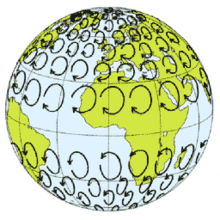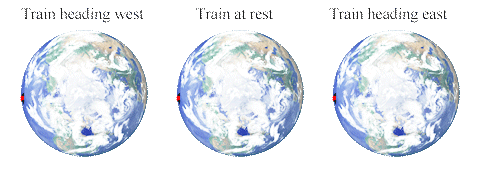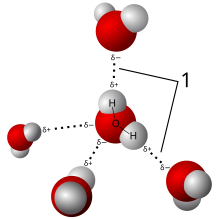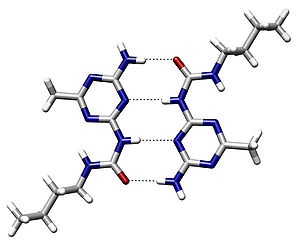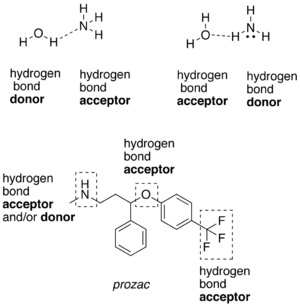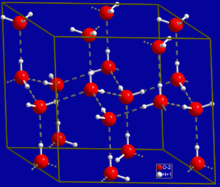From Wikipedia, the free encyclopedia
.

In the inertial frame of reference (upper part of the picture), the black ball moves in a straight line. However, the observer (red dot) who is standing in the rotating/non-inertial frame of reference (lower part of the picture) sees the object as following a curved path due to the Coriolis and centrifugal forces present in this frame.
In physics, the Coriolis force is an inertial force (also called a fictitious force) acting on objects which are in motion relative to a rotating reference frame. In a reference frame with clockwise rotation, the force acts to the left of the motion of the object; in one with anticlockwise rotation, the force acts to the right. Although recognized previously by others, the mathematical expression for the Coriolis force appeared in an 1835 paper by French scientist Gaspard-Gustave de Coriolis, in connection with the theory of water wheels. Early in the 20th century, the term Coriolis force began to be used in connection with meteorology. Deflection of an object due to the Coriolis force is called the 'Coriolis effect'.
Newton's laws of motion describe the motion of an object in an inertial (non-accelerating) frame of reference. When Newton's laws are transformed to a rotating frame of reference, the Coriolis force and centrifugal force appear. Both forces are proportional to the mass of the object. The Coriolis force is proportional to the rotation rate and the centrifugal force is proportional to its square. The Coriolis force acts in a direction perpendicular to the rotation axis and to the velocity of the body in the rotating frame and is proportional to the object's speed in the rotating frame. The centrifugal force acts outwards in the radial direction and is proportional to the distance of the body from the axis of the rotating frame. These additional forces are termed inertial forces, fictitious forces or pseudo forces.[1] They allow the application of Newton's laws to a rotating system. They are correction factors that do not exist in a non-accelerating or inertial reference frame.
A commonly encountered rotating reference frame is the Earth. The Coriolis effect is caused by the rotation of the Earth and the inertia of the mass experiencing the effect. Because the Earth completes only one rotation per day, the Coriolis force is quite small, and its effects generally become noticeable only for motions occurring over large distances and long periods of time, such as large-scale movement of air in the atmosphere or water in the ocean. Such motions are constrained by the surface of the Earth, so only the horizontal component of the Coriolis force is generally important. This force causes moving objects on the surface of the Earth to be deflected to the right (with respect to the direction of travel) in the Northern Hemisphere and to the left in the Southern Hemisphere. The horizontal deflection effect is greater near the poles and smallest at the equator, since the rate of change in the diameter of the circles of latitude when travelling north or south, increases the closer the object is to the poles.[2] Rather than flowing directly from areas of high pressure to low pressure, as they would in a non-rotating system, winds and currents tend to flow to the right of this direction north of the equator and to the left of this direction south of it. This effect is responsible for the rotation of large cyclones (see Coriolis effects in meteorology). To explain this intuitively, consider how an object that moves northwards from the equator has a tendency to maintain its greater speed at the equator (rotating around towards the right as you look at the sphere of the Earth), where the "horizontal diameter" is larger, and therefore tends to move towards the right as it passed northwards where the "horizontal diameter" of the Earth (the rings of latitude) is smaller, and the linear speed of local objects on the Earth's surface at that latitude is slower.
History
Italian scientists Giovanni Battista Riccioli and his assistant Francesco Maria Grimaldi described the effect in connection with artillery in the 1651 Almagestum Novum, writing that rotation of the Earth should cause a cannonball fired to the north to deflect to the east.[3] The effect was described in the tidal equations of Pierre-Simon Laplace in 1778.Gaspard-Gustave Coriolis published a paper in 1835 on the energy yield of machines with rotating parts, such as waterwheels.[4] That paper considered the supplementary forces that are detected in a rotating frame of reference. Coriolis divided these supplementary forces into two categories. The second category contained a force that arises from the cross product of the angular velocity of a coordinate system and the projection of a particle's velocity into a plane perpendicular to the system's axis of rotation. Coriolis referred to this force as the "compound centrifugal force" due to its analogies with the centrifugal force already considered in category one.[5][6] The effect was known in the early 20th century as the "acceleration of Coriolis",[7] and by 1920 as "Coriolis force".[8]
In 1856, William Ferrel proposed the existence of a circulation cell in the mid-latitudes with air being deflected by the Coriolis force to create the prevailing westerly winds.[9]
Understanding the kinematics of how exactly the rotation of the Earth affects airflow was partial at first.[10] Late in the 19th century, the full extent of the large scale interaction of pressure gradient force and deflecting force that in the end causes air masses to move 'along' isobars was understood.[citation needed]
Formula
In non-vector terms: at a given rate of rotation of the observer, the magnitude of the Coriolis acceleration of the object is proportional to the velocity of the object and also to the sine of the angle between the direction of movement of the object and the axis of rotation.The vector formula for the magnitude and direction of the Coriolis acceleration [11] is
 is the acceleration of the particle in the rotating system,
is the acceleration of the particle in the rotating system,  is the velocity of the particle with respect to the rotating system, and Ω is the angular velocity vector which has magnitude equal to the rotation rate ω and is directed along the axis of rotation of the rotating reference frame, and the × symbol represents the cross product operator.
is the velocity of the particle with respect to the rotating system, and Ω is the angular velocity vector which has magnitude equal to the rotation rate ω and is directed along the axis of rotation of the rotating reference frame, and the × symbol represents the cross product operator.The equation may be multiplied by the mass of the relevant object to produce the Coriolis force:
 .
.
- if the velocity is parallel to the rotation axis, the Coriolis acceleration is zero.
- if the velocity is straight inward to the axis, the acceleration is in the direction of local rotation.
- if the velocity is straight outward from the axis, the acceleration is against the direction of local rotation.
- if the velocity is in the direction of local rotation, the acceleration is outward from the axis.
- if the velocity is against the direction of local rotation, the acceleration is inward to the axis.
Causes
The Coriolis force exists only when one uses a rotating reference frame. In the rotating frame it behaves exactly like a real force (that is to say, it causes acceleration and has real effects). However, the Coriolis force is a consequence of inertia,[12] and is not attributable to an identifiable originating body, as is the case for electromagnetic or nuclear forces, for example. From an analytical viewpoint, to use Newton's second law in a rotating system, the Coriolis force is mathematically necessary, but it disappears in a non-accelerating, inertial frame of reference. For example, consider two children on opposite sides of a spinning roundabout (Merry-go-round ), who are throwing a ball to each other.From the children's point of view, this ball's path is curved sideways by the Coriolis force. Suppose the roundabout spins anticlockwise when viewed from above. From the thrower's perspective, the deflection is to the right.[13] From the non-thrower's perspective, deflection is to left. For a mathematical formulation see Mathematical derivation of fictitious forces.
An observer in a rotating frame, such as an astronaut in a rotating space station, very probably will find the interpretation of everyday life in terms of the Coriolis force accords more simply with intuition and experience than a cerebral reinterpretation of events from an inertial standpoint. For example, nausea due to an experienced push[clarification needed] may be more instinctively explained by the Coriolis force than by the law of inertia.[14][15] See also Coriolis effect (perception). In meteorology, a rotating frame (the Earth) with its Coriolis force provides a more natural framework for explanation of air movements than a non-rotating, inertial frame without Coriolis forces.[16] In long-range gunnery, sight corrections for the Earth's rotation are based upon the Coriolis force.[17] These examples are described in more detail below.
The acceleration entering the Coriolis force arises from two sources of change in velocity that result from rotation: the first is the change of the velocity of an object in time. The same velocity (in an inertial frame of reference where the normal laws of physics apply) will be seen as different velocities at different times in a rotating frame of reference. The apparent acceleration is proportional to the angular velocity of the reference frame (the rate at which the coordinate axes change direction), and to the component of velocity of the object in a plane perpendicular to the axis of rotation. This gives a term
 . The minus sign arises from the traditional definition of the cross product (right hand rule), and from the sign convention for angular velocity vectors.
. The minus sign arises from the traditional definition of the cross product (right hand rule), and from the sign convention for angular velocity vectors.The second is the change of velocity in space. Different positions in a rotating frame of reference have different velocities (as seen from an inertial frame of reference). In order for an object to move in a straight line it must therefore be accelerated so that its velocity changes from point to point by the same amount as the velocities of the frame of reference. The force is proportional to the angular velocity (which determines the relative speed of two different points in the rotating frame of reference), and to the component of the velocity of the object in a plane perpendicular to the axis of rotation (which determines how quickly it moves between those points). This also gives a term
 .
.Length scales and the Rossby number
The time, space and velocity scales are important in determining the importance of the Coriolis force. Whether rotation is important in a system can be determined by its Rossby number, which is the ratio of the velocity, U, of a system to the product of the Coriolis parameter, , and the length scale, L, of the motion:
, and the length scale, L, of the motion:
An atmospheric system moving at U = 10 m/s (22 mph) occupying a spatial distance of L = 1,000 km (621 mi), has a Rossby number of approximately 0.1.
A baseball pitcher may throw the ball at U = 45 m/s (100 mph) for a distance of L = 18.3 m (60 ft). The Rossby number in this case would be 32,000.
Needless to say, one does not worry about which hemisphere one is in when playing baseball. However, an unguided missile obeys exactly the same physics as a baseball, but may travel far enough and be in the air long enough to notice the effect of Coriolis force. Long-range shells in the Northern Hemisphere landed close to, but to the right of, where they were aimed until this was noted. (Those fired in the Southern Hemisphere landed to the left.) In fact, it was this effect that first got the attention of Coriolis himself.[19][20][21]
Simple cases
Cannon on turntable

Cannon at the center of a rotating turntable. To hit the target located at position 1 on the perimeter at time t = 0 s, the cannon must be aimed ahead of the target at angle θ. That way, by the time the cannonball reaches position 3 on the periphery, the target also will be at that position. In an inertial frame of reference, the cannonball travels a straight radial path to the target (curve yA). However, in the frame of the turntable, the path is arched (curve yB), as also shown in the figure.

Successful trajectory of cannonball as seen from the turntable for three angles of launch θ. Plotted points are for the same equally spaced times steps on each curve. Cannonball speed v is held constant and angular rate of rotation ω is varied to achieve a successful "hit" for selected θ. For example, for a radius of 1 m and a cannonball speed of 1 m/s, the time of flight tf = 1 s, and ωtf = θ → ω and θ have the same numerical value if θ is expressed in radians. The wider spacing of the plotted points as the target is approached show the speed of the cannonball is accelerating as seen on the turntable, due to fictitious Coriolis and centrifugal forces.
The animation at the top of this article is a classic illustration of Coriolis force. Another visualization of the Coriolis and centrifugal forces is this animation clip.
Given the radius R of the turntable in that animation, the rate of angular rotation ω, and the speed of the cannonball (assumed constant) v, the correct angle θ to aim so as to hit the target at the edge of the turntable can be calculated.
The inertial frame of reference provides one way to handle the question: calculate the time to interception, which is tf = R / v . Then, the turntable revolves an angle ω tf in this time. If the cannon is pointed an angle θ = ω tf = ω R / v, then the cannonball arrives at the periphery at position number 3 at the same time as the target.
No discussion of Coriolis force can arrive at this solution as simply, so the reason to treat this problem is to demonstrate Coriolis formalism in an easily visualized situation.
Trajectory in the Inertial Frame
The trajectory in the inertial frame (denoted A) is a straight line radial path at angle θ. The position of the cannonball in (x, y) coordinates at time t is:Accelerations
Components of Acceleration
To determine the components of acceleration, a general expression is used from the article fictitious force:Producing Accelerations
Producing a centrifugal acceleration:It is seen that the Coriolis acceleration not only cancels the centrifugal acceleration, but together they provide a net "centripetal", radially inward component of acceleration (that is, directed toward the center of rotation):[22]
These results also can be obtained directly by two time differentiations of rB (t). Agreement of the two approaches demonstrates that one could start from the general expression for fictitious acceleration above and derive the trajectories shown here. However, working from the acceleration to the trajectory is more complicated than the reverse procedure used here, which, of course, is made possible in this example by knowing the answer in advance.
As a result of this analysis an important point appears: all the fictitious accelerations must be included to obtain the correct trajectory. In particular, besides the Coriolis acceleration, the centrifugal force plays an essential role. It is easy to get the impression from verbal discussions of the cannonball problem, which are focussed on displaying the Coriolis effect particularly, that the Coriolis force is the only factor that must be considered;[23] emphatically, that is not so.[24] A turntable for which the Coriolis force is the only factor is the parabolic turntable. A somewhat more complex situation is the idealized example of flight routes over long distances, where the centrifugal force of the path and aeronautical lift are countered by gravitational attraction.[25][26]
Tossed ball on a rotating carousel
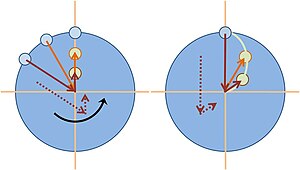
A carousel is rotating counter-clockwise. Left panel: a ball is tossed by a thrower at 12:00 o'clock and travels in a straight line to the center of the carousel. While it travels, the thrower circles in a counter-clockwise direction. Right panel: The ball's motion as seen by the thrower, who now remains at 12:00 o'clock, because there is no rotation from their viewpoint.
The figure illustrates a ball tossed from 12:00 o'clock toward the center of a counter-clockwise rotating carousel. On the left, the ball is seen by a stationary observer above the carousel, and the ball travels in a straight line to the center, while the ball-thrower rotates counter-clockwise with the carousel. On the right the ball is seen by an observer rotating with the carousel, so the ball-thrower appears to stay at 12:00 o'clock. The figure shows how the trajectory of the ball as seen by the rotating observer can be constructed.
On the left, two arrows locate the ball relative to the ball-thrower. One of these arrows is from the thrower to the center of the carousel (providing the ball-thrower's line of sight), and the other points from the center of the carousel to the ball.(This arrow gets shorter as the ball approaches the center.) A shifted version of the two arrows is shown dotted.
On the right is shown this same dotted pair of arrows, but now the pair are rigidly rotated so the arrow corresponding to the line of sight of the ball-thrower toward the center of the carousel is aligned with 12:00 o'clock. The other arrow of the pair locates the ball relative to the center of the carousel, providing the position of the ball as seen by the rotating observer. By following this procedure for several positions, the trajectory in the rotating frame of reference is established as shown by the curved path in the right-hand panel.
The ball travels in the air, and there is no net force upon it. To the stationary observer the ball follows a straight-line path, so there is no problem squaring this trajectory with zero net force. However, the rotating observer sees a curved path. Kinematics insists that a force (pushing to the right of the instantaneous direction of travel for a counter-clockwise rotation) must be present to cause this curvature, so the rotating observer is forced to invoke a combination of centrifugal and Coriolis forces to provide the net force required to cause the curved trajectory.
Bounced ball

Bird's-eye view of carousel. The carousel rotates clockwise. Two viewpoints are illustrated: that of the camera at the center of rotation rotating with the carousel (left panel) and that of the inertial (stationary) observer (right panel). Both observers agree at any given time just how far the ball is from the center of the carousel, but not on its orientation. Time intervals are 1/10 of time from launch to bounce.
The figure describes a more complex situation where the tossed ball on a turntable bounces off the edge of the carousel and then returns to the tosser, who catches the ball. The effect of Coriolis force on its trajectory is shown again as seen by two observers: an observer (referred to as the "camera") that rotates with the carousel, and an inertial observer. The figure shows a bird's-eye view based upon the same ball speed on forward and return paths. Within each circle, plotted dots show the same time points. In the left panel, from the camera's viewpoint at the center of rotation, the tosser (smiley face) and the rail both are at fixed locations, and the ball makes a very considerable arc on its travel toward the rail, and takes a more direct route on the way back. From the ball tosser's viewpoint, the ball seems to return more quickly than it went (because the tosser is rotating toward the ball on the return flight).
On the carousel, instead of tossing the ball straight at a rail to bounce back, the tosser must throw the ball toward the right of the target and the ball then seems to the camera to bear continuously to the left of its direction of travel to hit the rail (left because the carousel is turning clockwise). The ball appears to bear to the left from direction of travel on both inward and return trajectories. The curved path demands this observer to recognize a leftward net force on the ball. (This force is "fictitious" because it disappears for a stationary observer, as is discussed shortly.) For some angles of launch, a path has portions where the trajectory is approximately radial, and Coriolis force is primarily responsible for the apparent deflection of the ball (centrifugal force is radial from the center of rotation, and causes little deflection on these segments). When a path curves away from radial, however, centrifugal force contributes significantly to deflection.
The ball's path through the air is straight when viewed by observers standing on the ground (right panel). In the right panel (stationary observer), the ball tosser (smiley face) is at 12 o'clock and the rail the ball bounces from is at position one (1). From the inertial viewer's standpoint, positions one (1), two (2), three (3) are occupied in sequence. At position 2 the ball strikes the rail, and at position 3 the ball returns to the tosser. Straight-line paths are followed because the ball is in free flight, so this observer requires that no net force is applied.
Applied to the Earth
An important case where the Coriolis force is observed is the rotating Earth. Unless otherwise stated, directions of forces and motion apply to the Northern Hemisphere.Intuitive explanation
As the Earth turns around its axis, everything attached to it turns with it (imperceptibly to our senses). An object that is moving without being dragged along with this rotation travels in a straight motion over the turning Earth. From our rotating perspective on the planet, its direction of motion changes as it moves, bending in the opposite direction to our actual motion. When viewed from a stationary point in space above, any land feature in the Northern Hemisphere turns anticlockwise, and, fixing our gaze on that location, any other location in that hemisphere will rotate around it the same way. The traced ground path of a freely moving body travelling from one point to another will therefore bend the opposite way, clockwise, which is conventionally labeled as "right," where it will be if the direction of motion is considered "ahead" and "down" is defined naturally.Rotating sphere
Consider a location with latitude φ on a sphere that is rotating around the north-south axis.[27] A local coordinate system is set up with the x axis horizontally due east, the y axis horizontally due north and the z axis vertically upwards. The rotation vector, velocity of movement and Coriolis acceleration expressed in this local coordinate system (listing components in the order east (e), north (n) and upward (u)) are:
 is called the Coriolis parameter.
is called the Coriolis parameter.By setting vn = 0, it can be seen immediately that (for positive φ and ω) a movement due east results in an acceleration due south. Similarly, setting ve = 0, it is seen that a movement due north results in an acceleration due east. In general, observed horizontally, looking along the direction of the movement causing the acceleration, the acceleration always is turned 90° to the right and of the same size regardless of the horizontal orientation.
As a different case, consider equatorial motion setting φ = 0°. In this case, Ω is parallel to the north or n-axis, and:
For additional examples in this article see cannon on turntable and tossed ball. In other articles, see rotating spheres, apparent motion of stationary objects, and carousel.
Meteorology
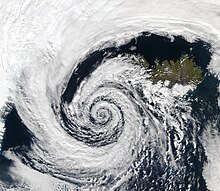
This low-pressure system over Iceland spins anticlockwise due to balance between the Coriolis force and the pressure gradient force.
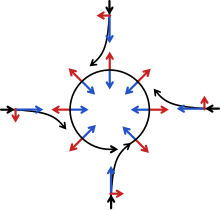
Schematic representation of flow around a low-pressure area in the Northern Hemisphere. The Rossby number is low, so the centrifugal force is virtually negligible. The pressure-gradient force is represented by blue arrows, the Coriolis acceleration (always perpendicular to the velocity) by red arrows
Perhaps the most important impact of the Coriolis effect is in the large-scale dynamics of the oceans and the atmosphere. In meteorology and oceanography, it is convenient to postulate a rotating frame of reference wherein the Earth is stationary. In accommodation of that provisional postulation, the centrifugal and Coriolis forces are introduced. Their relative importance is determined by the applicable Rossby numbers. Tornadoes have high Rossby numbers, so, while tornado-associated centrifugal forces are quite substantial, Coriolis forces associated with tornadoes are for practical purposes negligible.[28]
Because ocean currents are driven by the movement of wind over the water's surface, the Coriolis force also affects the movement of ocean currents and cyclones as well. Many of the ocean's largest currents circulate around warm, high-pressure areas called gyres. Though the circulation is not as significant as that in the air, the deflection caused by the Coriolis effect is what creates the spiraling pattern in these gyres. The spiraling wind pattern helps the hurricane form. The stronger the force from the Coriolis effect, the faster the wind will spin and pick up additional energy, increasing the strength of the hurricane.[29]
Air within high-pressure systems rotates in a direction such that the Coriolis force will be directed radially inwards, and nearly balanced by the outwardly radial pressure gradient. As a result, air travels clockwise around high pressure in the Northern Hemisphere and anticlockwise in the Southern Hemisphere. Air within low-pressure systems rotates in the opposite direction, so that the Coriolis force is directed radially outward and nearly balances an inwardly radial pressure gradient.[citation needed]
Flow around a low-pressure area
If a low-pressure area forms in the atmosphere, air will tend to flow in towards it, but will be deflected perpendicular to its velocity by the Coriolis force. A system of equilibrium can then establish itself creating circular movement, or a cyclonic flow. Because the Rossby number is low, the force balance is largely between the pressure gradient force acting towards the low-pressure area and the Coriolis force acting away from the center of the low pressure.Instead of flowing down the gradient, large scale motions in the atmosphere and ocean tend to occur perpendicular to the pressure gradient. This is known as geostrophic flow.[30] On a non-rotating planet, fluid would flow along the straightest possible line, quickly eliminating pressure gradients. Note that the geostrophic balance is thus very different from the case of "inertial motions" (see below) which explains why mid-latitude cyclones are larger by an order of magnitude than inertial circle flow would be.
This pattern of deflection, and the direction of movement, is called Buys-Ballot's law. In the atmosphere, the pattern of flow is called a cyclone. In the Northern Hemisphere the direction of movement around a low-pressure area is anticlockwise. In the Southern Hemisphere, the direction of movement is clockwise because the rotational dynamics is a mirror image there. At high altitudes, outward-spreading air rotates in the opposite direction.[31] Cyclones rarely form along the equator due to the weak Coriolis effect present in this region.
Inertial circles
An air or water mass moving with speed subject only to the Coriolis force travels in a circular trajectory called an 'inertial circle'. Since the force is directed at right angles to the motion of the particle, it will move with a constant speed around a circle whose radius
subject only to the Coriolis force travels in a circular trajectory called an 'inertial circle'. Since the force is directed at right angles to the motion of the particle, it will move with a constant speed around a circle whose radius  is given by:
is given by: is the Coriolis parameter
is the Coriolis parameter  , introduced above (where
, introduced above (where  is the latitude). The time taken for the mass to complete a full circle is therefore
is the latitude). The time taken for the mass to complete a full circle is therefore  . The Coriolis parameter typically has a mid-latitude value of about 10−4 s−1; hence for a typical atmospheric speed of 10 m/s (22 mph) the radius is 100 km (62 mi), with a period of about 17 hours. For an ocean current with a typical speed of 10 cm/s (0.22 mph), the radius of an inertial circle is 1 km (0.6 mi). These inertial circles are clockwise in the Northern Hemisphere (where trajectories are bent to the right) and anticlockwise in the Southern Hemisphere.
. The Coriolis parameter typically has a mid-latitude value of about 10−4 s−1; hence for a typical atmospheric speed of 10 m/s (22 mph) the radius is 100 km (62 mi), with a period of about 17 hours. For an ocean current with a typical speed of 10 cm/s (0.22 mph), the radius of an inertial circle is 1 km (0.6 mi). These inertial circles are clockwise in the Northern Hemisphere (where trajectories are bent to the right) and anticlockwise in the Southern Hemisphere.If the rotating system is a parabolic turntable, then
 is constant and the trajectories are exact circles. On a rotating planet,
is constant and the trajectories are exact circles. On a rotating planet,  varies with latitude and the paths of particles do not form exact circles. Since the parameter
varies with latitude and the paths of particles do not form exact circles. Since the parameter  varies as the sine of the latitude, the radius of the oscillations associated with a given speed are smallest at the poles (latitude = ±90°), and increase toward the equator.[32]
varies as the sine of the latitude, the radius of the oscillations associated with a given speed are smallest at the poles (latitude = ±90°), and increase toward the equator.[32]Other terrestrial effects
The Coriolis effect strongly affects the large-scale oceanic and atmospheric circulation, leading to the formation of robust features like jet streams and western boundary currents. Such features are in geostrophic balance, meaning that the Coriolis and pressure gradient forces balance each other. Coriolis acceleration is also responsible for the propagation of many types of waves in the ocean and atmosphere, including Rossby waves and Kelvin waves. It is also instrumental in the so-called Ekman dynamics in the ocean, and in the establishment of the large-scale ocean flow pattern called the Sverdrup balance.Eötvös effect
The practical impact of the "Coriolis effect" is mostly caused by the horizontal acceleration component produced by horizontal motion.There are other components of the Coriolis effect. Westward-travelling objects will be deflected downwards (feel heavier), while Eastward-travelling objects will be deflected upwards (feel lighter).[33] This is known as the Eötvös effect. This aspect of the Coriolis effect is greatest near the equator. The force produced by this effect is similar to the horizontal component, but the much larger vertical forces due to gravity and pressure mean that it is generally unimportant dynamically.
In addition, objects travelling upwards (i.e., out) or downwards (i.e., in) will be deflected to the west or east respectively. This effect is also the greatest near the equator. Since vertical movement is usually of limited extent and duration, the size of the effect is smaller and requires precise instruments to detect. However, in the case of large changes of momentum, such as a spacecraft being launched into orbit, the effect becomes significant. The fastest and most fuel-efficient path to orbit is a launch from the equator which curves to a directly eastward heading.
Intuitive example
One can imagine a train that travels through a frictionless railway line along the equator assuming that when it is in motion it does so at the necessary speed to complete a trip around the world in one day (465 m/s).[34] The Coriolis effect can be considered in three cases: when the train travels west; when it is at rest and finally when it is travelling east. For each of this cases the Coriolis effect can be calculated from the rotating frame of reference on Earth first and then it can be checked against a fixed inertial frame. In the image below, the three cases are illustrated in an inertial frame as observed from a fixed point above Earth along its axis of rotation:- 1. The train travels toward the west: In that case, it is moving against the direction of rotation. Therefore, on the Earth's rotating frame the Coriolis term will be pointed inwards towards the axis of rotation (down). This additional force downwards should cause the train to be heavier while moving in that direction.
- If one looks at this train from the fixed non-rotating frame on top of the center of the Earth, at that speed it remains stationary as the Earth spins beneath it. Hence, the only force acting on it would be gravity and the reaction from the track. This force is greater (by 0.34%)[34] than the force that the passengers and the train experience when at rest (rotating along with Earth). This difference is what the Coriolis effect accounts for in the rotating frame of reference.
- 2. The train comes to a stop: From the point of view on the Earth's rotating frame, the velocity of the train is zero, thus the Coriolis force is also zero and the train and its passengers recuperate their usual weight.
- From the fixed inertial frame of reference above Earth, the train is now rotating along with the rest of the Earth. 0.34% of the force of gravity provides the centripetal force needed to achieve the circular motion on that frame of reference. The remaining force, as could be measured by a scale, would make the train and its passengers "lighter" than in the previous case.
- 3. The train changes direction and travels towards the East. In this case, as it is moving in the direction of Earth's rotating frame, the Coriolis term will be directed outward from the axis of rotation (up). This upward force would cause the train to seem lighter still than when at rest.
- From the fixed frame of reference on space, the train travelling east will now be rotating at twice the rate as when it was at rest and therefore the amount of centripetal force needed to cause that circular path increases leaving less force from gravity to act on the track. This is what the Coriolis term accounts for on the previous paragraph.
- As a final check one can imagine a frame of reference rotating along with the train. Such frame would be rotating at twice the angular velocity as Earth's rotating frame. The resulting centrifugal force component for that imaginary frame would be greater. Since the train and its passengers are at rest, that would be the only component in that frame explaining again why the train and the passengers are lighter than in the previous two cases.
The above example can be used to explain why the Eötvös effect starts diminishing on an object travelling westward as its tangential speed increases above Earth's rotation (465 m/s). If the westward train in the above example increases its speed, part of the force of gravity that was pushing against the track will account for the centripetal force needed to keep it in circular motion on the inertial frame. Once the train doubles its westward speed at 930 m/s that centripetal force will be equal to the force experienced by the train when it stops. From the inertial frame, in both cases it rotates at the same speed but in the opposite directions. Thus, the force is the same cancelling completely the Eötvös effect. Any object moving westward at a speed above 930 m/s would experience an upward force instead. In the figure, the Eötvös effect is illustrated for a 10 gram object on the train at different speeds. The parabolic shape is because the centripetal force is proportional to the square of the tangential speed. On the inertial frame, the bottom of the parabola would be centered at the origin. The offset is because, in this argument, the Earth's rotating frame of reference is being used. From the graph, it can be seen that the Eötvös effect is not symmetrical, and that the resulting downward force experienced by an object travelling west at high velocity is less than the resulting upward force when it is travelling east at the same speed.
Draining in bathtubs and toilets
Contrary to popular misconception, water rotation in home bathrooms under normal circumstances is not related to the Coriolis effect or to the rotation of the Earth, and no consistent difference in rotation direction between toilet drainage in the Northern and Southern Hemispheres can be observed. The formation of a vortex over the plug hole may be explained by the conservation of angular momentum: The radius of rotation decreases as water approaches the plug hole, so the rate of rotation increases, for the same reason that an ice skater's rate of spin increases as they pull their arms in. Any rotation around the plug hole that is initially present accelerates as water moves inward.Of course, the Coriolis force does still impact the direction of the flow of water, but only minutely. Only if the water is so still that the effective rotation rate of the Earth is faster than that of the water relative to its container, and if externally applied torques (such as might be caused by flow over an uneven bottom surface) are small enough, the Coriolis effect may indeed determine the direction of the vortex. Without such careful preparation, the Coriolis effect will likely be much smaller than various other influences on drain direction[36] such as any residual rotation of the water[37] and the geometry of the container.[38] Despite this, the idea that toilets and bathtubs drain differently in the Northern and Southern Hemispheres has been popularized by several television programs and films, including Escape Plan, Wedding Crashers, The Simpsons episode "Bart vs. Australia", and The X-Files episode "Die Hand Die Verletzt".[39] Several science broadcasts and publications, including at least one college-level physics textbook, have also stated this.[40][41]
In 1908, the Austrian physicist Ottokar Tumlirz described careful and effective experiments which demonstrated the effect of the rotation of the Earth on the outflow of water through a central aperture.[42] The subject was later popularized in a famous 1962 article in the journal Nature, which described an experiment in which all other forces to the system were removed by filling a 6 ft (1.8 m) tank with 300 U.S. gal (1,100 L) of water and allowing it to settle for 24 hours (to allow any movement due to filling the tank to die away), in a room where the temperature had stabilized. The drain plug was then very slowly removed, and tiny pieces of floating wood were used to observe rotation. During the first 12 to 15 minutes, no rotation was observed. Then, a vortex appeared and consistently began to rotate in an anticlockwise direction (the experiment was performed in Boston, Massachusetts, in the Northern Hemisphere). This was repeated and the results averaged to make sure the effect was real. The report noted that the vortex rotated, "about 30,000 times faster than the effective rotation of the Earth in 42° North (the experiment's location)". This shows that the small initial rotation due to the Earth is amplified by gravitational draining and conservation of angular momentum to become a rapid vortex and may be observed under carefully controlled laboratory conditions.[43][44]
Ballistic trajectories
The Coriolis force became important in external ballistics for calculating the trajectories of very long-range artillery shells. The most famous historical example was the Paris gun, used by the Germans during World War I to bombard Paris from a range of about 120 km (75 mi). Similarly, a bullet does not fly straight from the barrel to a target. The Coriolis force minutely changes the trajectory of a bullet, curving the path of the projectile into a more arched 'semi-circle' shape. This effect only affects accuracy at extremely long distances and is therefore adjusted for by accurate long-distance shooters, such as snipers and other trained professionals.[17]The effects of the Coriolis force on ballistic trajectories should not be confused with the curvature of the paths of missiles, satellites, and similar objects when the paths are plotted on two-dimensional (flat) maps, such as the Mercator projection. The projections of the three-dimensional curved surface of the Earth to a two-dimensional surface (the map) necessarily results in distorted features. The apparent curvature of the path is a consequence of the sphericity of the Earth and would occur even in a non-rotating frame.
Visualization of the Coriolis effect
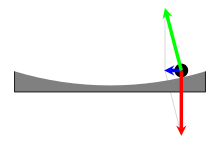
The forces at play in the case of a curved surface.
Red: gravity
Green: the normal force
Blue: the net resultant centripetal force.
Red: gravity
Green: the normal force
Blue: the net resultant centripetal force.
To demonstrate the Coriolis effect, a parabolic turntable can be used. On a flat turntable, the inertia of a co-rotating object would force it off the edge. But if the surface of the turntable has the correct paraboloid (parabolic bowl) shape (see the figure) and is rotated at the corresponding rate, the force components shown in the figure are such that the component of gravity tangential to the bowl surface will exactly equal the centripetal force necessary to keep the object rotating at its velocity and radius of curvature (assuming no friction). (See banked turn.) This carefully contoured surface allows the Coriolis force to be displayed in isolation.[45][46]
Discs cut from cylinders of dry ice can be used as pucks, moving around almost frictionlessly over the surface of the parabolic turntable, allowing effects of Coriolis on dynamic phenomena to show themselves. To get a view of the motions as seen from the reference frame rotating with the turntable, a video camera is attached to the turntable so as to co-rotate with the turntable, with results as shown in the figure. In the left panel of the figure, which is the viewpoint of a stationary observer, the gravitational force in the inertial frame pulling the object toward the center (bottom ) of the dish is proportional to the distance of the object from the center. A centripetal force of this form causes the elliptical motion. In the right panel, which shows the viewpoint of the rotating frame, the inward gravitational force in the rotating frame (the same force as in the inertial frame) is balanced by the outward centrifugal force (present only in the rotating frame). With these two forces balanced, in the rotating frame the only unbalanced force is Coriolis (also present only in the rotating frame), and the motion is an inertial circle. Analysis and observation of circular motion in the rotating frame is a simplification compared to analysis or observation of elliptical motion in the inertial frame.
Because this reference frame rotates several times a minute rather than only once a day like the Earth, the Coriolis acceleration produced is many times larger and so easier to observe on small time and spatial scales than is the Coriolis acceleration caused by the rotation of the Earth.
In a manner of speaking, the Earth is analogous to such a turntable.[47] The rotation has caused the planet to settle on a spheroid shape, such that the normal force, the gravitational force and the centrifugal force exactly balance each other on a "horizontal" surface. (See equatorial bulge.)
The Coriolis effect caused by the rotation of the Earth can be seen indirectly through the motion of a Foucault pendulum.

 .
.






















![\left. {\color{white}...}\ \omega v \left(\cos\alpha + \omega t \sin \alpha \right) \right]\](http://upload.wikimedia.org/math/1/d/e/1deca9eb44de4997c7fb777624af4551.png)













